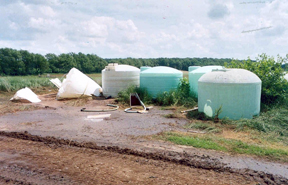How to check poly tank condition using three different methods
Checking poly tank integrity is vital to ensure that a farm does not have an economic and environmental disaster
Agricultural producers use polyethylene – poly for short – for many uses on the farm, such as chemical storage, chemical applications or watering tanks. Poly tanks have a tremendous benefit over other types of tanks; they can be cheaper, available in various sizes, corrosive resistant and compatible with many different liquids. There is, however, one drawback with poly tanks: they will fail. The key to good poly tank management is to know the condition of the tank before it cracks or ruptures.

Photo 1. A collapsed, 28-percent poly tank like this can cause an environmental and economic disaster. Photo credit: Jack Knorek, MDA
Tank integrity is measured by three indicators: scratches, crazing and cracks. Scratches are on the surface and they can be seen and felt.
Crazing is a network of fine lines or cracks, which may look like a patchwork that cannot be seen with a visual inspection. Crazing is within the tank wall and can be a sign of deterioration of the plastic, which may lead to cracks. Tanks that show signs of crazing will still hold liquids, but the integrity of the tank is questionable, so caution should be used in putting any hazardous substance in it.
Cracks can be visually seen and felt and extend through the plastic wall. Cracks may run parallel or at right angles.
Testing poly tanks is a simple procedure. There are three different methods that can be used after the tank has been in use: candling, using a water soluble marker and the ever popular bat method. If you purchased a new tank you should fill it with water and let it set overnight before you put any hazardous substance in it to ensure that there are no leaks. For all of the methods, first do a visual inspection looking for any scratches or surface damage.
Candling is using light to visually inspect a tank. You will need a bright cool light for this procedure. The first step is to inspect the outside of the tank. Place a light, flood light or a very bright flashlight inside the tank while you look on the outside for any cracks or crazes. The next step is to inspect the inside of the tank. Place the light on the outside of the tank and have someone look through the fill opening. Do not allow anyone to put their head inside the tank. You may want to consider using a camera to record the inspection from the top of the tank.
Marking the tank with a water soluble marker is a good, safe way to determine if your tank has integrity problems. This method will show you if you have crazing issues as well as cracks. Start by checking the areas that get the most UV, or sunlight, exposure. Rub a water soluble marker in a six inch by six inch section and then quickly wipe it off with a paper towel or dry cloth. If there is any crazing or cracking, the ink has penetrated the tank surface. Repeat this procedure in several locations on the tank checking for crazing. If the test reveals cracking or spider webbing with the lines going in all directions, this is a sign of deterioration. Test this tank often and if possible only use it for water. If the test reveals a checkered appearance, this could mean “dry rot” and the tank will lose its ability to expand and will become brittle. These tanks should be replaced or only used for water. If your tank has parallel lines, this is the early stages of UV damage and the tank should be monitored. If the lines are around the fittings, the tank should be replaced immediately or only used for water.
The third method to test poly tanks is the bat method, which involves testing the empty tank’s brittleness by hitting it with a baseball bat. This method is the simplest and, depending on your temperament, the most therapeutic. This is a great method to check tanks that have cracking on them. A good poly tank is flexible and needs to bend in and out as it is filled and emptied. Tanks that are brittle lose their ability to expand under pressure and to move when impacted.
For more information, check out the Purdue Extension bulletin, PPP-77 “Poly tanks for Farms and Businesses…preventing catastrophic failures.”



 Print
Print Email
Email



